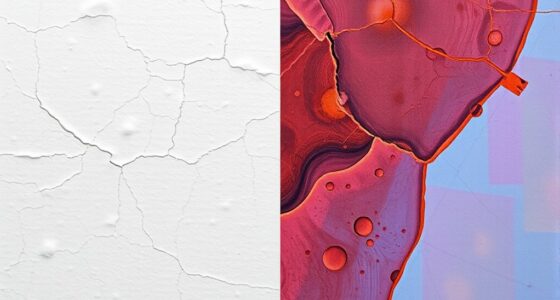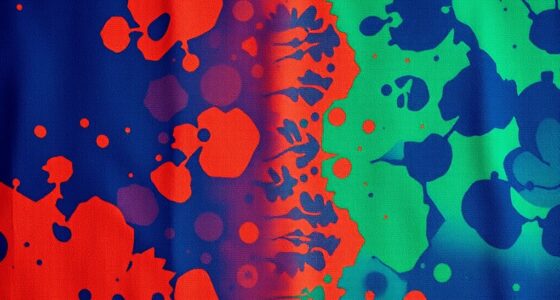Understanding fabric weaves, stretch, and grain is essential for successful sewing projects. The weave affects the fabric’s appearance and how it handles; for example, satin has a shiny finish but can be tricky to sew, while plain weave is easier and more stable. Stretch fabrics require special handling to keep their elasticity, and aligning fabric grains guarantees your garments hang correctly and maintain shape. Keep exploring to master these important sewing fundamentals.
Key Takeaways
- Understanding fabric weaves like plain, twill, and satin helps predict texture, appearance, and sewing difficulty.
- Recognizing fabric grain ensures proper cutting and sewing, maintaining garment shape and drape.
- Stretch fabrics require careful handling to preserve elasticity and prevent distortion during sewing.
- Selecting the right fiber type (cotton, polyester, silk, wool) influences care, durability, and comfort of finished projects.
- Proper handling of weave, stretch, and grain optimizes sewing results and garment longevity.

Have you ever wondered what makes one piece of fabric feel different from another? The secret lies in the fiber types and how the fabric is constructed. Understanding the variety of fiber types—such as cotton, polyester, wool, silk, and blends—helps you recognize their unique qualities. For example, cotton feels soft and breathable, perfect for summer garments, while wool offers warmth and durability. Knowing the fiber types also guides your fabric care, as each type demands specific washing, drying, and ironing methods to keep it looking its best. For instance, delicate silk requires gentle handling, whereas sturdy cotton can withstand more rigorous cleaning. When selecting fabrics for your sewing projects, paying attention to fiber types ensures longevity and comfort, making your finished garments more enjoyable to wear.
Understanding fiber types helps you choose fabrics that are comfortable, durable, and easy to care for.
Moving beyond fiber types, the way fabric is woven or knitted greatly influences its drape, strength, and appearance. Weaves like plain, twill, and satin each create different textures and stability, affecting how your project will turn out. For instance, a tight satin weave lends a luxurious shine but can be tricky to sew without puckering, while a more open plain weave might be easier to work with but less lustrous. Recognizing these differences helps you choose the right fabric for your project and handle it properly during sewing. Stretch fabrics, created through special knit constructions or added elastic fibers, let your projects move naturally with your body. They’re ideal for activewear or fitted garments, but require careful handling to maintain their stretch and shape. Additionally, understanding the fabric grain is essential for achieving a professional-looking finish, as it impacts how the fabric drapes and retains its shape over time.
The fabric grain is another fundamental concept that impacts your sewing success. The grain refers to the orientation of the threads in the fabric, and aligning your pattern pieces along the correct grain ensures your project hangs properly. Cutting against the grain can cause garments to twist, warp, or lose their shape over time. To identify the grain, look for the selvage edge—the tightly woven edge that runs parallel to the warp threads. Always align your pattern pieces with the grain to guarantee a professional finish. Additionally, paying attention to the fabric’s nap or pile, especially in fabrics like velvet or corduroy, helps you cut pieces in the same direction for a consistent look.
Mastering fabric care, understanding fiber types, and recognizing weave, stretch, and grain all contribute to successful sewing projects. When you select fabrics thoughtfully, handle them correctly, and follow care instructions, your garments will look better, last longer, and feel more comfortable. Keep these principles in mind, and you’ll find sewing becomes easier, more enjoyable, and more satisfying as you craft pieces that stand the test of time.
Frequently Asked Questions
How Do I Identify the Right Fabric for Beginner Sewing Projects?
To pick the right fabric for beginner sewing projects, start by considering fabric weight and texture. Choose lightweight fabrics like cotton or linen—they’re easy to handle and sew. Feel the fabric to assess its texture; smooth and soft fabrics are generally easier to work with. Avoid overly stretchy or heavy fabrics at first. By focusing on these aspects, you’ll find fabrics that help you learn quickly and create successful projects.
What Are Common Fabric Mistakes to Avoid?
Did you know that improper fabric care can shorten your textile’s lifespan by up to 50%? To avoid common fabric mistakes, always store fabric properly in a cool, dry place to prevent mold and fading. Be cautious with fabric care instructions, as ignoring them can cause shrinking or damage. Using the wrong fabric for your project or rushing through cutting and sewing can also lead to mistakes, so take your time and follow guidelines carefully.
How Does Fabric Quality Affect Sewing Outcomes?
Fabric quality greatly impacts your sewing outcomes by ensuring durability and a polished look. High-quality fabric resists issues like uneven fabric dyeing and poor fabric finishing, which can cause color fading or stiffness. When you choose better fabric, you’ll find it easier to sew smoothly, achieve professional results, and avoid wasting time on repairs. Investing in quality fabric ultimately saves you effort and results in garments that last longer and look better.
Can Fabric Types Influence Garment Durability?
Think of fabric types as the armor of your garments. They directly influence durability through fabric strength and wear resistance. Heavier, tightly woven fabrics like denim or canvas are more resilient, standing up better to daily wear. Lighter fabrics may tear or fray more easily. So, selecting the right fabric guarantees your garment lasts longer, keeps its shape, and withstands the test of time and activity.
What Tools Help Determine Fabric Stretch and Grain?
To determine fabric stretch and grain, you’ll need a clear ruler or tape measure to test how much the fabric stretches in different directions. A straightedge or fabric grain ruler helps you identify the fabric grain, ensuring proper alignment during sewing. Additionally, gently pulling the fabric along the grain and crosswise reveals its stretch capacity. These tools help you achieve accurate cuts and better-fitting garments, making your sewing projects more successful.
Conclusion
Now that you’ve unraveled the basics of fabric weaves, stretch, and grain, you’re ready to navigate your sewing projects with confidence. Think of fabric as a dance partner—you’ll want to move in harmony, understanding its twists and turns. Mastering these fundamentals helps your creations flow effortlessly from idea to finished piece. With this knowledge in your toolkit, sewing becomes less of a puzzle and more like painting with fabric—each stitch a brushstroke in your unique design story.








